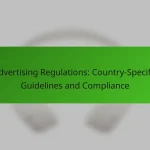Click-through rate (CTR) is a vital metric that gauges the effectiveness of online content by measuring the percentage of users who click on a specific link relative to the total views. Understanding and optimizing CTR is essential for enhancing engagement in display advertising, as it directly impacts traffic and conversion rates. By refining ad placement, creative elements, and audience targeting, advertisers can significantly boost their CTR and overall campaign performance.

How to improve click-through rates in display advertising?
Improving click-through rates (CTR) in display advertising involves strategic adjustments to ad placement, creative elements, and audience targeting. By focusing on these areas, advertisers can significantly enhance engagement and drive more traffic to their websites.
Optimize ad placement
Ad placement is crucial for maximizing visibility and engagement. Position ads in high-traffic areas of a webpage, such as above the fold or near relevant content. Consider using heat maps to identify where users spend the most time on a page.
Experiment with different placements across various devices. For instance, mobile users may respond better to ads placed at the bottom of the screen, while desktop users might engage more with sidebar ads. Regularly analyze performance metrics to refine your strategy.
Enhance ad creatives
High-quality ad creatives can significantly boost CTR. Use eye-catching visuals and compelling copy that resonates with your target audience. Ensure that your ads are not only visually appealing but also clearly convey the value proposition.
Incorporate strong calls-to-action (CTAs) that encourage users to click. Phrases like “Learn More” or “Get Started Today” can create a sense of urgency. A/B testing different creative elements can help determine what works best for your audience.
Utilize A/B testing
A/B testing is a powerful method to improve CTR by comparing two versions of an ad to see which performs better. Test different headlines, images, and CTAs to identify the most effective combinations. This data-driven approach allows for continuous optimization.
Make sure to run tests long enough to gather significant data, ideally over several weeks. Analyze the results and implement the winning variations in your campaigns to enhance overall performance.
Target specific demographics
Targeting specific demographics can lead to higher CTRs by ensuring that your ads reach the right audience. Use data analytics to identify key characteristics of your ideal customers, such as age, gender, location, and interests.
Utilize platforms that allow for precise demographic targeting, such as Google Ads or Facebook Ads. Tailor your messaging and creatives to resonate with these specific groups, increasing the likelihood of engagement.
Leverage retargeting strategies
Retargeting is an effective strategy to improve CTR by re-engaging users who have previously interacted with your brand. By showing ads to users who visited your site but did not convert, you can remind them of your offerings and encourage them to return.
Implement retargeting campaigns across various platforms, adjusting the frequency and messaging based on user behavior. This approach can lead to higher conversion rates, as these users are already familiar with your brand and more likely to engage again.

What factors influence click-through rates?
Click-through rates (CTR) are influenced by various factors that determine how effectively an ad captures audience attention and encourages action. Key elements include ad relevance, format, audience targeting, and the effectiveness of the call-to-action.
Ad relevance
Ad relevance refers to how well an advertisement aligns with the interests and needs of its target audience. Ads that resonate with viewers are more likely to generate clicks, as they provide solutions or information that the audience seeks.
To enhance ad relevance, conduct thorough keyword research and understand your audience’s pain points. Tailoring your message to address these concerns can significantly improve CTR.
Ad format
The format of an ad plays a crucial role in attracting clicks. Different formats, such as text, image, video, or interactive ads, can yield varying levels of engagement. For instance, video ads often have higher CTRs compared to static images due to their dynamic nature.
Experiment with various formats to identify which resonates best with your audience. A/B testing can help determine the most effective layout and design for your specific campaign goals.
Audience targeting
Effective audience targeting ensures that your ads reach the right people. By utilizing demographic, geographic, and behavioral data, you can tailor your ads to specific segments, increasing the likelihood of engagement.
Consider using tools like Google Ads or Facebook Ads Manager to refine your targeting criteria. Narrowing your audience can lead to higher CTRs as the ads become more relevant to those who see them.
Call-to-action effectiveness
The call-to-action (CTA) is a critical component that prompts users to take the desired action. A strong, clear CTA can significantly boost CTR by guiding users on what to do next, such as “Shop Now” or “Learn More.”
To optimize your CTA, use action-oriented language and ensure it stands out visually within the ad. Testing different CTAs can reveal which phrases or placements drive the most clicks, allowing for continuous improvement.

What is the definition of click-through rate?
Click-through rate (CTR) is a metric that measures the percentage of users who click on a specific link compared to the total number of users who view a page, email, or advertisement. It is a crucial indicator of how effectively content engages an audience.
Ratio of clicks to impressions
The click-through rate is calculated by dividing the number of clicks by the number of impressions and then multiplying by 100 to get a percentage. For example, if an ad receives 100 clicks out of 1,000 impressions, the CTR would be 10%. This ratio helps assess the effectiveness of marketing efforts.
Generally, a higher CTR indicates that the content is relevant and appealing to the audience. Typical CTRs can vary widely by industry, with average rates often ranging from 1% to 5% for online ads.
Key performance indicator in advertising
In advertising, CTR serves as a key performance indicator (KPI) that helps marketers evaluate the success of their campaigns. A higher CTR can lead to better ad placements and lower costs per click, as platforms like Google Ads often reward ads with higher engagement rates.
To optimize CTR, advertisers should focus on creating compelling headlines, using clear calls to action, and targeting the right audience. Regularly testing different ad formats and messages can also help identify what resonates best with potential customers.

How does click-through rate impact advertising success?
Click-through rate (CTR) significantly influences advertising success by indicating how effectively an ad attracts potential customers. A higher CTR often correlates with better ad performance, leading to improved visibility and lower costs per click.
Influences ad quality score
Click-through rate directly affects an ad’s quality score, which is a metric used by platforms like Google Ads to assess the relevance and quality of ads. A higher CTR can lead to a better quality score, resulting in lower costs and higher ad placements.
To improve your quality score, focus on creating compelling ad copy and targeting the right audience. Regularly analyze your CTR and make necessary adjustments to enhance engagement.
Affects overall campaign ROI
CTR plays a crucial role in determining the return on investment (ROI) for advertising campaigns. A higher CTR typically leads to more conversions, thereby increasing overall ROI. Conversely, a low CTR may indicate that your ads are not resonating with your target audience.
To maximize ROI, regularly monitor your CTR and experiment with different ad formats, targeting options, and messaging. Aim for a CTR that aligns with industry benchmarks, which can vary but often fall between 1% and 5% for many sectors.

What are the best practices for optimizing click-through rates?
To optimize click-through rates (CTR), focus on creating engaging content that resonates with your target audience. Implementing effective strategies can significantly enhance your visibility and engagement metrics.
Use compelling headlines
Compelling headlines are crucial for attracting attention and encouraging clicks. Aim for headlines that are clear, concise, and evoke curiosity or urgency. Using action words and numbers can also increase engagement.
For example, a headline like “10 Tips to Boost Your Productivity” is more enticing than “Productivity Tips.” Experiment with different styles and formats to see what resonates best with your audience.
Incorporate eye-catching visuals
Visual elements, such as images, infographics, and videos, can significantly enhance your content’s appeal and improve CTR. High-quality visuals draw the eye and can convey information quickly and effectively.
Consider using relevant images that complement your headlines and text. For instance, an infographic summarizing key points can encourage users to click through to learn more. Ensure that visuals are optimized for fast loading to prevent user drop-off.









